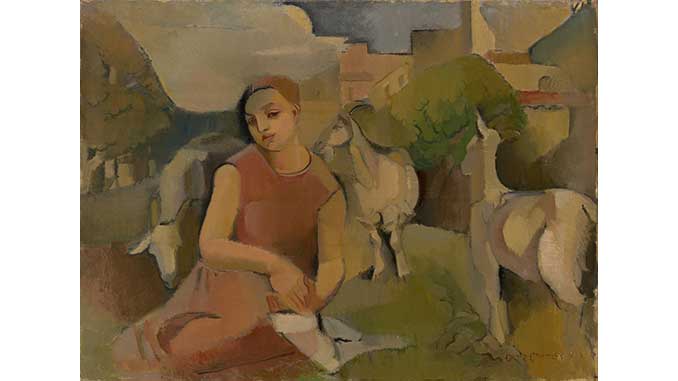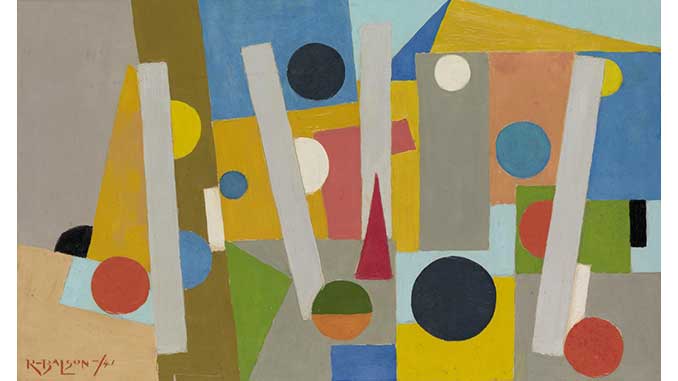 Grace Crowley & Ralph Balson is the first-ever major exhibition to explore in-depth the longstanding creative partnership and artistic synergies between pioneering abstract artists Grace Crowley (1890-1979) and Ralph Balson (1890-1964).
Grace Crowley & Ralph Balson is the first-ever major exhibition to explore in-depth the longstanding creative partnership and artistic synergies between pioneering abstract artists Grace Crowley (1890-1979) and Ralph Balson (1890-1964).
Opening 23 May 2024 at The Ian Potter Centre: NGV Australia, the exhibition charts their radical leap into pure abstraction, and the important role they played in shaping the modern art movement in Australia.
Painting exclusively together for many decades, Crowley and Balson’s dynamic exchange extended and challenged both artists. Crowley and Balson respectively produced some of the earliest and most important works of abstract art in the country.
Their collaborative approach to painting – the sharing of ideas, techniques and materials – resulted in two significant bodies of work that broke new ground in Australian art.
By presenting the work of Crowley and Balson together, the exhibition invites audiences to trace the shared influences and harmonies between their works, as well as to appreciate the centrality of collaboration to their individual practices.
The exhibition comprises more than 75 paintings and works on paper, with some of these never-before-seen by the Australian public, and drawn from Victorian and interstate collections, major institutions including the Art Gallery of New South Wales and National Gallery of Australia, regional and private collections.
Highlights from the exhibition include Grace Crowley’s Girls with goats, 1928 (pictured above). This work was completed at André Lhote’s summer school held in the medieval township of Mirmande, France, which Crowley attended with fellow Australian artists Dorrit Black and Anne Dangar.
The composition of the painting is constructed upon the ratios of the golden mean and highlights the geometric reduction of form that was taught at Lhote’s academy.
On display is Crowley’s semi-abstract Portrait, 1939, which anticipates pure abstraction in its total rejection of traditional modes of rendering realistic form and space. When Portrait was recently examined in the NGV paintings conservation studio in preparation for display, it was discovered that the backing board was in fact hiding a Ralph Balson painting.
The recently discovered painting is consistent with Balson’s Constructive paintings from the early 1940s, and incorporates distinct compositional motifs found in other works that he exhibited at this time. This newly discovered never-before-seen Balson work will make its debut in the Grace Crowley & Ralph Balson exhibition.
 Other exhibition highlights include a selection of paintings from Balson’s 1941 solo exhibition at Anthony Hordern’s Fine Art Galleries in Sydney – the first exhibition of solely pure abstraction in Australia. Balson showcased a suite of geometric abstractions works that featured intersecting planes of colour.
Other exhibition highlights include a selection of paintings from Balson’s 1941 solo exhibition at Anthony Hordern’s Fine Art Galleries in Sydney – the first exhibition of solely pure abstraction in Australia. Balson showcased a suite of geometric abstractions works that featured intersecting planes of colour.
Referred to by the artist, and often titled accordingly, as ‘Constructive paintings’, this was a watershed moment in Australian art history which was relatively overlooked at the time.
“Instrumental in the development of abstract art in Australia, Grace Crowley and Ralph Balson were extraordinary artists whose partnership and collaborative practice had an indelible influence on the trajectory of modern art in this country,” said Tony Ellwood AM, Director NGV.
“This is the first exhibition to place their oeuvres in direct conversation, allowing audiences to see first-hand the intimate nature of their long-term technical and creative exchange.”
Grace Crowley grew up in Barraba, in country New South Wales, and commenced full-time studies at Julian Ashton’s Sydney Art School in 1915, before being appointed Head Teacher in 1918.
During the interwar years, Crowley travelled to France, where she studied with André Lhote and Albert Gleizes, who were both were early pioneers of the cubist movement. Crowley returned to Australia in 1930, where she became a central figure in the distribution of modernist ideas.
Ralph Balson was born in Dorset, England, and at thirteen he was apprenticed to a plumber and house painter before moving to Sydney ten years later. Predominantly a self-educated artist, in the early 1920s he commenced night classes at the Sydney Art School, where one of his teachers was Grace Crowley.
His work as a house painter enabled him to effortlessly handle large areas of paint. An intensely private person, Balson gave few interviews, and there are only two known existing photographs of him – one being his passport photo from 1960.
In Sydney in 1932, Crowley established an art school with fellow artist Rah Fizelle, which became a major hub for the exchange of modern ideas and central to a group of progressively abstract artists, including Ralph Balson. Following the closure of the school, the duo began painting exclusively in a partnership that would last more than three decades.
Crowley and Balson were included in the seminal show Exhibition 1, the inaugural display of semi-abstract painting and sculpture in Australia, which was held at David Jones Gallery in 1939. In 1954, Crowley moved to Mittagong, and a studio was set up for Balson. From this point, Crowley was to paint very little. Conversely, this was a prolific period for Balson, who retired the following year.
Following Balson’s death in 1964, Crowley actively promoted Balson’s career over her own, underplaying her own contribution to their artistic relationship. The extent of her contribution is further obscured by significant gaps in her extant body of works, due to the well-documented fact that the artist destroyed or discarded many of her own paintings.
Grace Crowley & Ralph Balson
The Ian Potter Centre: NGV Australia at Fed Square, Melbourne
Exhibition: 23 May 2024 – 22 September 2024
Free entry
For more information, visit: www.ngv.melbourne for details.
Images: Grace Crowley, Girl with goats, 1928, oil on canvas, 54.4 x 73.4 cm, National Gallery of Victoria, Melbourne. Presented by the National Gallery Society of Victoria, 1967. © National Gallery of Victoria | Ralph Balson, Painting no. 14, 1941, oil on cardboard, 47.3 x 78.8 cm, National Gallery of Victoria, Melbourne. Loti & Victor Smorgon Fund, 2012. © Ralph Balson Estate
